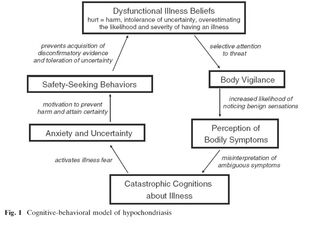Health
What's Behind Your Health Anxiety?
How thoughts and behaviors are the culprit.
Posted September 23, 2021 Reviewed by Vanessa Lancaster
Key points
- Health anxiety is reinforced by a complicated cognitive and behavioral process.
- Dysfunctional beliefs about health and illness play a key role in interpreting symptoms and bodily sensations.
- Body vigilance makes it more likely for someone to notice symptoms and bodily sensations.
Health anxiety is the worst. At times, there can be a seemingly constant flux of bodily sensations or symptoms to worry about. A headache, random heart palpitation, or stomach ache can send you into a tailspin of worries, anxiety, body checking, googling, doctor visits, scans, and tests. The whole process is exhausting.
Why Does This Happen?
Cognitive researchers delineate a common process among those with health anxiety that includes various thoughts and behaviors. The diagram below outlines this process well.

As you can see, a whole lot is happening here. This process ultimately becomes a vicious cycle that can be difficult to stop. Let's break down each component.
Dysfunctional Beliefs About Illness
You developed certain inaccurate or dysfunctional beliefs, assumptions, and thoughts about health and illness at some point in your life. Researchers have identified several common beliefs among people with health anxiety (e.g., beliefs about disease being common, beliefs about not being able to cope with the disease, distrust of doctors and medical resources, assumptions that it is necessary or possible to be 100% certain about health status at all times). Once these beliefs are set in motion, the process of reinforcement begins. You start to seek out information that confirms that belief (e.g. my friend's cousin was diagnosed with cancer at 35) and then disregard or ignore information that disconfirms the belief (e.g. most people in my life are generally healthy). As a result, dysfunctional beliefs are strengthened over time.
Body Vigilance
When you have core beliefs about disease being more prevalent and severe, you naturally look for these threats. You pay very close attention to all bodily sensations. Why wouldn't you do this if you believe serious diseases are common and medical resources can't help you? You monitor for symptoms, check for changing moles or lumps, or monitor blood pressure, heart rate, or breathing. But, of course, since you are on hyper-alert, you are bound to notice something, right?
Catastrophic Explanations of Bodily Sensations or Symptoms
Any time a new bodily sensation or symptom appears, you begin to imagine various potential explanations. You tend to engage in what are called cognitive distortions or thinking errors. For example, you engage in all-or-nothing thinking, in which you believe that any symptoms point to bad health, and to be in reasonable health means to have zero symptoms at all times. As a result of thinking errors, people typically develop explanations that are not common, benign illnesses. Instead, they are severe or even catastrophic illnesses (e.g., cancer, stroke, heart attack, multiple sclerosis).
Anxiety and Uncertainty
You then experience anxiety due to this newly hypothesized disease (anyone would if they thought they might die)—fear of the unknown kicks into high gear at this point. You become overwhelmed by the uncertainty of your symptoms and feel compelled to find answers now.
Safety-Seeking Behaviors
At this point, you are in a state of great fear and feel that you must do something to save yourself from this impending doom. So you engage in “safety behaviors” or behaviors that you believe might prevent the impact of this potential disease. You might go to multiple doctors, get a range of tests done, seek reassurance from friends or family members or spend a night down the google rabbit hole.
It's Over, but It's Not Really Over
Once you’ve consulted with a doctor or had tests done, all might be fine and dandy for a little while because you (briefly) believe you are healthy again. But you still hold those pesky core beliefs about health and illness. And, so, once a new bodily sensation pops up (or an old one continues or reemerges), you are right back to square one again. Getting stuck in this cycle can be pretty awful!
What Can Be Done?
The key here is to interrupt this cycle. Dysfunctional or inaccurate thoughts and beliefs need to be challenged to help you reshape the way you see health and disease. It is also essential to help you refrain from using safety behaviors to know that such techniques don’t prevent you from getting a severe illness. All of this can be done through a range of cognitive and behavioral interventions. CBT to the rescue!
References
Abramowitz, J., Olatunji, B., & Deacon, B. (2007). Health anxiety, hypochondriasis, and the anxiety disorders, Behavior Therapy, 38 (1), 86-94, https://doi.org/10.1016/j.beth.2006.05.001.


